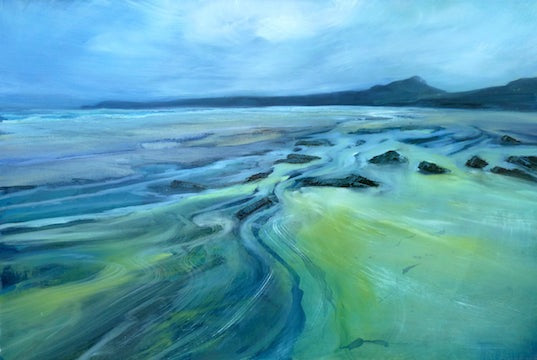“Being there… and not being there”
by John Mercer
It is easy to find average landscape paintings; there is an abundance of painters who turn out any number of them and offer them for sale in teashops near any place of natural beauty. The best of them bring a shard of the landscape to the living room and give a brief sprinkle of delight to the viewer only for it to fade into the furniture over a surprisingly short space of time. Very few landscape paintings catapult the viewer into the landscape itself. Sarah Jane Brown achieves this with a combination of scale, vision and subtlety.
“Her seascapes are as much about you the viewer as they are about her and the landscape she lives in.”
It takes courage of vision to create large canvases. Landscape is something that, in the real world, fills the eye – so to do less, could diminish the impact of the scene which so often happens – (remember all those holiday snaps of rolling hills rendered almost meaningless by the lack of scale). At worst this lack of scale makes a painting seem like a landscape seen through a camera lens compressing everything to a single depth. And camera snaps is how, for many people, the idea of landscape has been transformed from an experience into a room decoration.
Landscape fills the mind: It is an intricate and fundamental part of the nation’s psyche. We cannot divorce the idea of who we are from the place in which we build our lives – and how little we acknowledge the richness and influence of that landscape. The scene is also a state of mind. It reflects the spaces in which our creative senses find scope to improvise their own mode of living and for Sarah Brown is also a meditation on the joining of land and sea.
Her first exhibition of seascapes, taken mainly from the Pembrokeshire coast where she lives, was magnificently unsettling. One expects the nice and charming – not the dramatic and arresting. It takes only moments to realise that we are in the presence of a different order of seascapes – ones that have something to contribute to our view of the world.
“Sarah Jane has things to say about her part of the world and her images demand that you pay attention.”
The size of the works is a measure of her commitment to that dialogue. She uses the scale to give space to reveal the many layers in the work, of the brush stroking the canvas many times in the same place searching for the line and coaxing fluidity from a flat surface with colours that must stay in place but which, in effect, are forever moving.
It is no small wonder that in the history of painting the ability to convey depth has been a prize that caused the great to travel across Europe to witness its depiction. It does not arise from a few technical tricks but from a sense of unity with the space of the world – and from many years of experience – hence the feeling that this cannot be a first exhibition but perhaps just the first time her works have stood together as a complete set in which the visitor may feel their way into her way of seeing the world.
As you sit with one of Sarah Jane’s images something happens. You stop interpreting and begin to inhabit. Then the inhabitation becomes something else; a merging with the subject matter, that takes the viewer to the scene rather than the other way round, and in a still moment you may discover some things about yourself whilst you are there.
John Mercer is a music producer, writer and art collector. Based near Cambridge, he is involved in a variety of creative projects.













